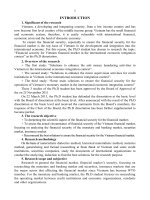Financial accounting in an economic context 8e chapter 06
Bạn đang xem bản rút gọn của tài liệu. Xem và tải ngay bản đầy đủ của tài liệu tại đây (650.79 KB, 38 trang )
1
Chapter 6:
The Current Asset Classification,
Cash and Accounts Receivable
2
Current Asset Classification
A current asset is defined as any asset that is intended to be
converted into cash within one year or the company’s
operating cycle, whichever is longer.
3
Figure 6-2
4
Current Assets / Current Liabilities
5
Limitations of the Current Asset Classification
As
noted by Leopold A. Bernstein,
“The current ratio is not fully up to the task
[of assessing short-term liquidity] because it
is a static or “stock” concept of what
resources are available at a given moment
to meet the obligations at that moment.”
6
Cash
7
Proper Management of Cash
Restrictions
placed on a company’s
access to its cash are typically imposed
by creditors to help ensure future
interest and principal payments.
Compensating balances are
sometimes required
Record Control over cash
Physical Control over cash
8
Accounts Receivable
Accounts receivable arise from selling goods
or services to customers on account.
Recorded at face amount to be collected.
However, we must also reflect the fact that a
portion of A/R may not be collected.
– Net Realizable Value
Reasons for lack of collection:
1. sales discounts (cash discounts)
2. sales returns
3. sales allowances
4. uncollectible A/R (bad debts)
9
1. Cash Discounts
Offered to encourage early payment
Examples
• 2/10, net 30
• 2/10, EOM
Accounting approaches
• Gross Method - records discounts when taken
by customers
• Net Method - records discounts not taken by
customers
10
Recording sales discounts
The gross method
Assume a $100 sale, terms 2/10, n/30
The sale is recorded:
Debit
Accounts Receivable
Sales
Credit
100
100
11
Recording sales discounts
The gross method
If
paid within 10 days:
Debit
Cash
Sales Discounts
Accounts Receivable
Credit
98
2
100
A contra-account to Sales Revenue
12
Recording sales discounts
The gross method
If
paid after 10 days:
Debit
Cash
Accounts Receivable
Credit
100
100
Will not disclose that discount was not taken
13
Gross Method
Make year end estimate of amount of
discounts expected to be taken
Adjusting entry:
SALES DISCOUNTS
ALLOWANCE FOR SALES DISCOUNTS
14
Recording sales discounts
The net method
Assume a $100 sale, terms 2/10, n/30
The sale is recorded:
Debit
Accounts Receivable
Sales
Credit
98
98
15
Recording sales discounts
The net method
If
paid within 10 days:
Debit
Cash
Accounts Receivable
Credit
98
98
Will not disclose that discount was taken
16
Recording sales discounts
The net method
If
paid after 10 days:
Debit
Cash
Credit
100
Sales Discounts
Forfeited
Accounts Receivable
Report as miscellaneous revenue
2
98
17
Net Method
Record sale net of cash discounts
Record discounts not taken (similar to
interest income)
Make year end adjustment for accounts that
are past the discount period
Adjusting entry:
ACCOUNTS RECEIVABLE
SALES
18
Theory
Discounts are more like interest
If so, the Gross Method
• Overstates Sales
• Understates Interest Income
Defense for use of the Gross Method?
• Materiality
19
2. Sales Returns and Allowances
If sales returns are small in amount, adjust A/R and
create a contra to Sales called Sales Returns when
the merchandise is returned. Sales allowances are
negotiated reductions in sales price after the sale.
Sales Allowance xx
Sales Returnsxx
A/R
xx
If sales returns are significant (e.g., bookstore),
company must estimate the amount of sales
returns expected, and adjust A/R (with a contra
account similar to Allowance for Bad Debts) at the
end of the period.
Estimated Sales Returns
xx
Allowance for Returns xx
20
3. Allowance for Doubtful Accounts
Created as a contra account to A/R to indicate the
portion of A/R that will not be collected due to
defaults on payments by customers.
Reason for Allowance account: Assume $1,000
sale in 2008 and default on collection in 2009.
Record sale in 2008:
A/R
1,000
Sales Revenue
1,000
Record default in 2009:
Bad Debt Expense 1,000
A/R
1,000
Note: this is called the direct method, and is not
GAAP, for the reasons listed on the next page.
21
Problems with Direct Method
Problem: the direct method, on the previous
slide, does not achieve matching (revenues
recognized in 2008, but a related expense was
recognized in 2009).
Problem: the direct method does not correctly
value the asset, A/R. The assets are overvalued
until 2009, when the receivable is written off.
22
Solution: the Allowance Method
Solution: create a contra to A/R, and estimate
the A/R that will not be collected.
The AJE to record an estimate for
uncollectibles in 2008 (for all uncollectibles):
Bad Debt Expense 4,000
Allowance
4,000
The GJE during 2009, when a specific A/R is
deemed uncollectible (this is called the writeoff of a specific A/R):
Allowance
1,000
A/R
1,000
When are the income statement and balance
At the 2008 estimate.
sheet affected?
23
Estimation of Uncollectibles
Note that we do not know in 2008 which A/Rs will
not be collected in 2009. Therefore, we must
estimate uncollectibles. There are two methods:
1. Percentage of sales
2. Percentage of accounts receivable
Both methods are used to estimate
uncollectibles for the AJE. The percentage of
sales method is simpler, but the percentage of
A/R method is more accurate.
Under IFRS, the methods used to estimate and
account for uncollectible are very similar to
those under US GAAP.
24
1. Percentage of Sales Method
Usually based on credit sales, but may use
total sales or net sales as basis.
Calculation:
Sales x % = Bad Debt Expense
(focus on the debit side of the AJE)
Called the Income Statement approach,
because: revenues x % = expense.
25









